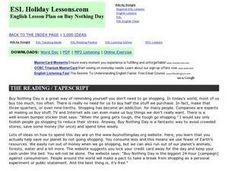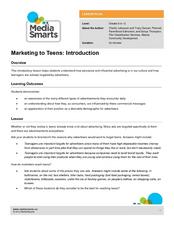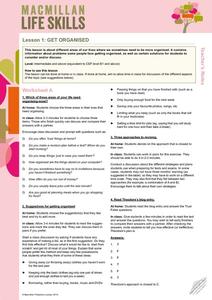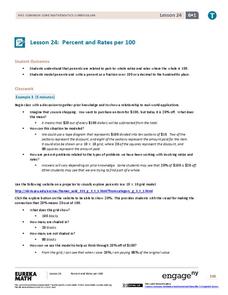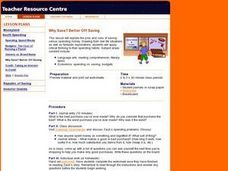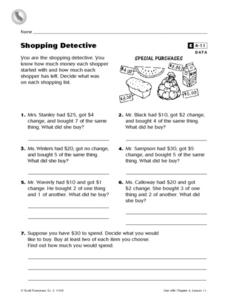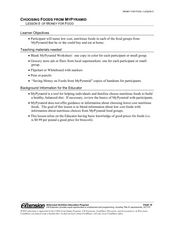Curated OER
ESL Holiday Lessons: Plan on Buy Nothing Day
In this ESL holiday lesson learning exercise, students read a passage about Buy Nothing Day, then complete a variety of comprehension and vocabulary activities.
Curated OER
How to Protect Your Money
Students determine how to protect themselves from monetary scams. They look at how scams are initiated, what they may can do in response to solicitation, and how to keep their money safe. They practice telling phone and home solicitors...
Growing Minds
Apple Exploration
Turn your classroom into a farmers' market! Reading Applesauce Season by Eden Ross Lipson or Monica Wellington’s Apple Farmer Annie, launches this investigation of apples, farmers' markets, and the people selling products. The class...
Curated OER
Marketing to Teens: Introduction
An introductory lesson plan shows learners how pervasive and influential advertising is in our culture; particularly, how teenagers are actively targeted by advertisers. As teenagers, your learners already have all the information they...
Macmillan Education
Get Organised
The focus of the first lesson in a 23-lesson life skills unit is on getting organized. The worksheets ask users to identify areas of their lives were they need more organization and then offer suggestions and solutions.
EngageNY
Percent and Rates per 100
What percentage of your class understands percents? Pupils learn the meaning of percents based upon rates per 100 in the 24th lesson plan in a series of 29. They represent percents as fractions, decimals, ratios, and models. The scholars...
Curated OER
Why Save? Better Off Saving
Middle schoolers examine the pros and cons of saving versus spending money and evaluate real-life situations as well as their own spending habits. They discuss the best and worst purchase they have made and why, explore the "Downtown...
Curated OER
Monthly Cost of Living - Food
Young scholars determine how much they would need to feed a family for a month. They plan meals and use Internet grocery stores to find the cost of individual food items. They brainstorm in small groups to come up with 1 weeks worth of...
Curated OER
Shopping Detective
In this consumer math worksheet, students analyze the prices on 4 food items in a store. Students solve 7 word problems with the information.
Curated OER
Money for Food
Students identify low cost, nutritious foods from each of the food groups. In this low cost nutrition lesson, students use the handout "Saving Money on Foods from MyPyramid" and work in groups to study grocery store ads to find foods in...
Curated OER
Wants and Needs
Here is an outstanding lesson on wants versus needs designed for 1st graders. Pupils listen to the book, Something Good which presents themes on wants, needs, choice, resources, and counting money. Pupils complete worksheets embedded in...
Curated OER
By the Pound
Agriculture surrounds us every day; incorporate measuring tools into a study of Oklahoma's agricultural industry! Small groups read an informational text (included) before visiting stations where they investigate prices of various...
Curated OER
Shopping at The Classroom Store
First graders participate in a simulation where they purchase items from a store. They choose items to purchase, total the amount on a calculator, and gather the exact change to make their purchase.
Curated OER
A Safe Place For My Money
Middle schoolers examine the roles of different types of financial institutions. They also identify the basic accounts found at the institutions. They ask questions to representatives that come and speak to the class.
Curated OER
Budgeting
Students explore what butgeting means. In this mathematics lesson, students determine that certain things need to be part of a budget like food and clothing by answering real-life types of questions on whether one should save money and...
Curated OER
Math Bargains
First graders use real coins or concrete models of coins to solve problems involving the purchase of items. They use cons and simulate going to a bargain store to purchase items. Students record the total cost of items. Pupils make a...
Curated OER
Moving Out
Students determine their cost of living. In this determining their cost of living lesson, students think of ten necessary things they would need if they moved out of their parents house. Students research the cost of renting...
Perkins School for the Blind
The Price is Right
Go on a shopping trip to practice estimation, price value, and shopping skills. The class heads off to the market to purchase several items for the activity. While they are there, they discuss the cost of various foods and even...
National Association of Teacher Educators for Family and Consumer Science
Consumerism in the Classroom: Effective Strategies for Today's Teenage Consumers
Help class members become savvy consumers with a series of activities that has them analyzing marketing strategies, comparing the value of brand name versus off-brand clothing, and considering the advantages and...
Curated OER
Pronoun Case
As a quick way to review pronouns, this activity could be used after a lesson on the topic. The 10 questions on the worksheet require students to identify the correct pronouns for use in each of the sentences.
Curated OER
Thinking About Shopping and Spending
Students list and discuss recent commercials they have viewed. They identify advantages and disadvantages of the advertised items, and write about the effects of advertising, planned spending and spontaneous spending.
Curated OER
Christmas Shopping on the Internet
Students utilize the Internet as a research tool as they "shop" on the Internet for a list of Christmas gifts. In groups, they compare prices, shop for the best price and make sure to spend no more than $300.
Curated OER
Vamos de compras!
Students identify articles of clothing in Spanish. Using the internet, they interpret information from department stores in Spain and Panama. They practice converting pesetas to dollars in order to determine how much they can spend. ...
Curated OER
Banking on the Future
Students solve problems involving interest. In this investing activity, students investigate the pros and cons of investing in a bank account and stocks. They differentiate between aggressive and conservative investments.


